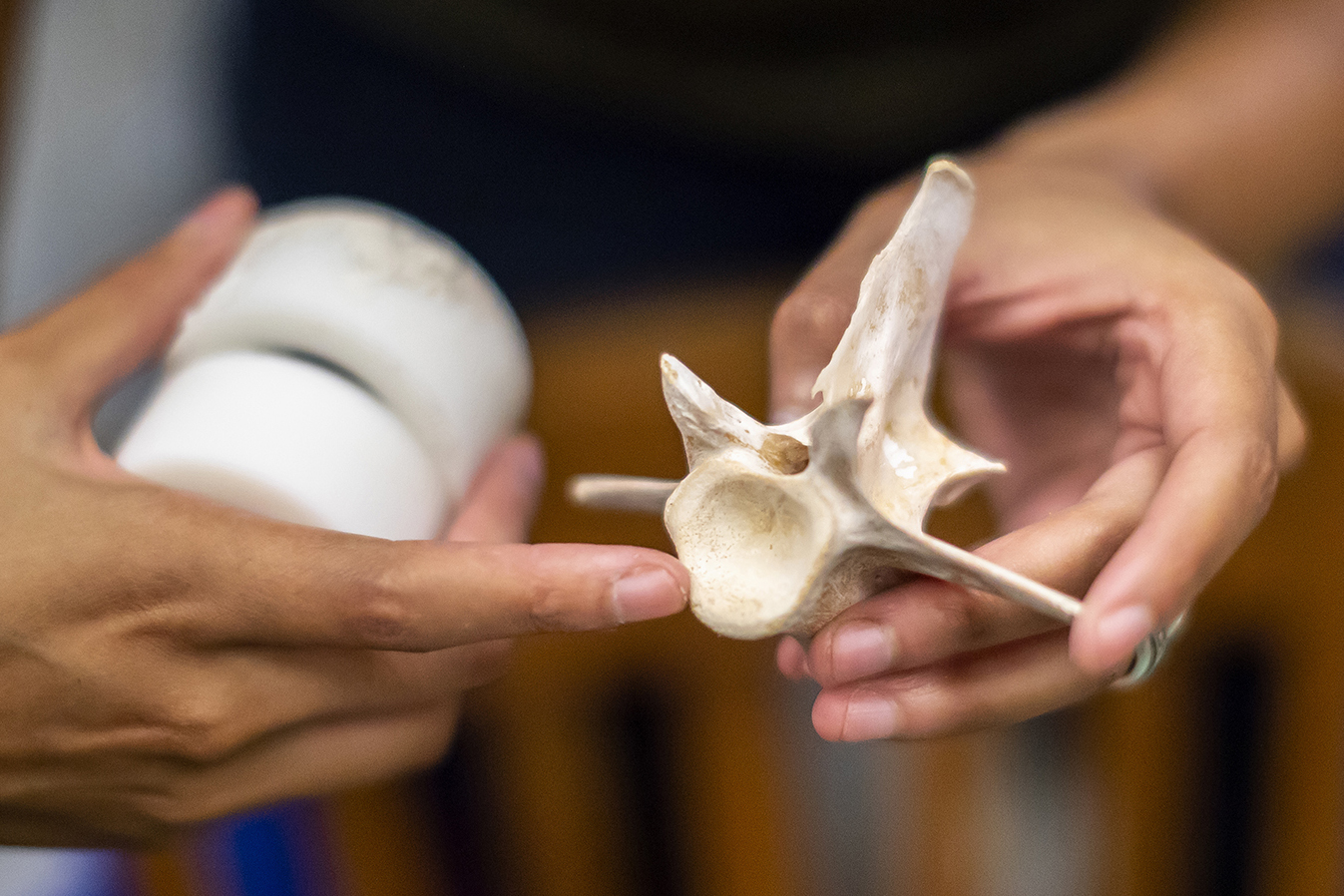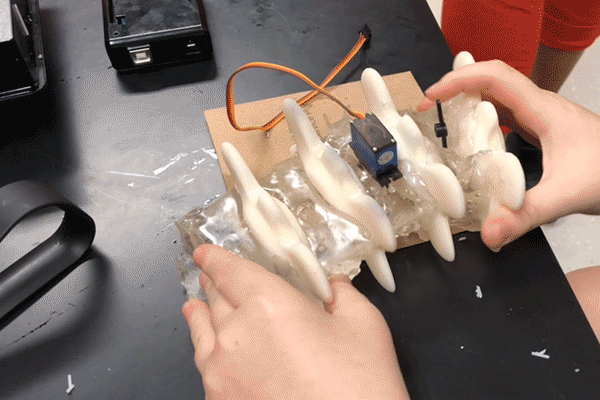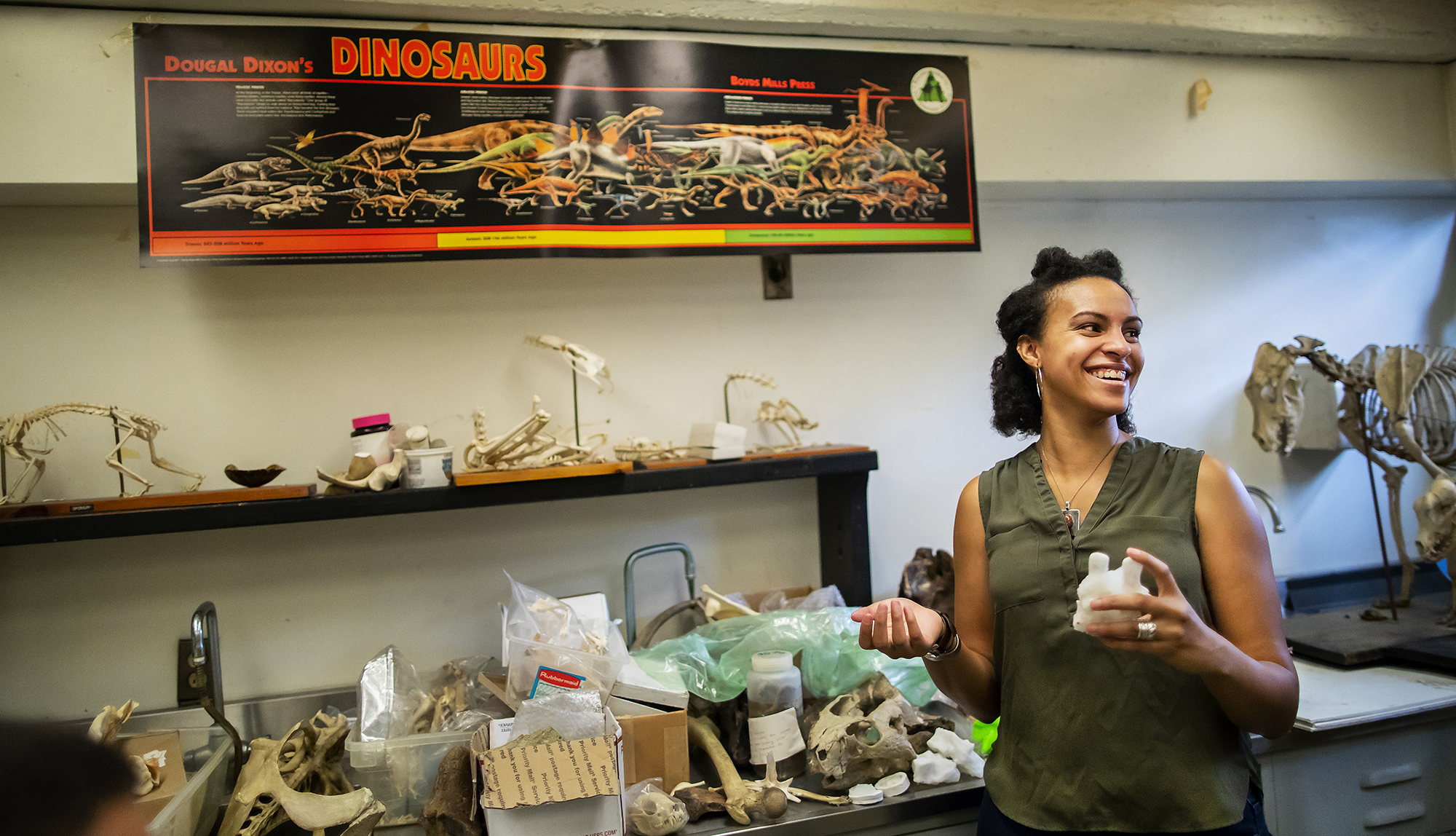Traditional robots have a hard time navigating natural environments, such as a forest floor or a rocky surface. They’re usually designed to perform in a fixed location with extreme accuracy, so their movements often don’t translate well to dynamic areas.
An emerging field called bio-inspired robotics addresses these issues by drawing inspiration from mechanical processes that occur in nature, hoping to mimic the movement that evolution has already developed for dealing with tough terrain.
“When you build a robot—for instance, a rescue robot—you need to build it for the environment it will be used in,” says Aja Carter, a doctoral candidate in paleontology in the Department of Earth and Environmental Science in the School of Arts and Sciences. “Evolution has already run these experiments. Evolution has run more experiments than we as humans will ever run. Paleontologists can take these natural experiments and then apply it to enhance things like better rescue robots.”
Carter is carving out a specialty within bio-inspired robotics, which she calls paleo-bio-inspired robotics. She decided to help improve the ability of robots to move successfully on land by analyzing how that same challenge was conquered by the first living creatures to do so: early tetrapods, the ancient four-legged vertebrates that were the first animals to crawl out of water and walk on land.
Carter has borrowed several fossilized spines that belonged to these early tetrapods from the American Museum of Natural History, including one from Archeria, found in the Red Beds of Archer County, Texas. Archeria appeared eel-like and could grow up to seven feet long, but because the amphibian had basic limbs, it could navigate both water and land. The Red Beds are comprised of sedimentary rocks, including sandstone and red mudstone, and the rock formations contain fossils from the Permian Era, which occurred from about 300 million to 250 million years ago.
Specimens like Carter’s Archeria are extremely rare and not exactly durable, so Carter takes a CT scan of each spine, converts those scans into 3-D models, and then 3-D prints each vertebra in resin at the Penn Biomedical Library, thanks to the Greg and Susan Walker Endowment. To complete the vertebral column and make the spines as true-to-life as possible, Carter then inserts silicone “cartilage” between each of the vertebrae. Next, she aligns small, programmable motors on either side of the vertebral column that propel the robotic spines to move as though they’re navigating across land. From 300 million years ago to now, tetrapods that successfully navigated rocks, fallen trees, and other land structures persisted, while those that couldn’t navigate the terrain did not.
But until now, these types of fossils have not been analyzed for potential biomimetic properties. Biomechanists, who apply the principles of mechanics to the structure or movement of biological organisms, have already explored differences in movement between modern fishes and salamanders, but modern-day animals don’t move quite like early tetrapods.
“You can’t point to any one animal in the world that looks like this or moves like this,” Carter says, holding an Archeria vertebra made out of white resin. “So, we built it.” She smiles. “This thing hasn’t moved in a very long time—about 300 million years. We’re making it move, which is so exciting.”
Research on modern animals has previously focused on locomotive traits involving tail usage or muscle activation. But since these locomotive traits had not been analyzed in fossilized specimens, there isn’t a blueprint for this new research.
“I want to be able to find what in the fossil record was best suited to this early environment,” says Carter. “I want to be able to ask: What is this shape? How does it move, and what does it do? And how could it be better? And then put that work into designing robots.”
Even the slightest changes in vertebral column movement could have been beneficial for movement on land, so Carter has plenty of questions to not only ask, but discover.
“That’s what makes this exciting and challenging,” she says. “Testing appropriate methods, testing appropriate materials, all of the baseline stuff hasn’t been done yet. When going from a CT scan to a 3-D printer, what kind of printer should I use? What about the scaling of the bones? I’m making up a procedure while I’m answering a question, and part of the question is the procedure.
“On top of making extinct monsters move, I’m also developing a method,” Carter says. “The techniques to do what I do don’t exist, so I’m making them. I’m using techniques from the past used by paleontologists in the 1800s, but I’m stuck in the future.”
These early methods were used by some of the first paleontologists back when rock formations in the western United States were littered with fossils. Casting and molding, a method still frequently used in fossil preparatory labs, consists of pouring a mold of silicone or a similar material around the original specimen, such as an Archeria vertebra, and then removing the original specimen from the mold. The mold can then be used to create multiple casts.
Carter has designed several vertebral column models, and will be presenting her research at the Geological Society of America’s 130th annual meeting this fall in Indianapolis. Her session will include other researchers who want to advance standardized methods for developing and testing materials to use in empirical paleontological research.
“We are only beginning to guess the directions that Aja’s work will take,” says Peter Dodson, Carter’s dissertation advisor, a professor of paleontology in the Department of Earth and Environmental Science, and a professor of anatomy in the School of Veterinary Medicine. “One of the most exciting potential developments is in the field of robotics. She has her eye set on rescue robots, which would be a remarkable outcome.”
Dodson says he has known Carter since she was a high school student. Carter “practically grew up in the Academy of Natural Sciences,” Dodson says, where she spent time volunteering in a fossil preparatory lab. He kept an eye on Carter’s hard work during her undergraduate years at Drexel University in paleontologist Ken Lacovara’s lab, where Carter got to work on world-famous Dreadnoughtus, believed to be the heaviest dinosaurs of all time. Dodson then recruited Carter to the Ph.D. program at Penn.
Dodson describes Carter as an outstanding character who’s passionate about her work. “I’ve had the pleasure of seeing her expand into a plethora of fields: physiology, biomechanics, bioengineering, and robotics. I always learn from my students, but [Carter] has taken me with her on her intellectual journey and it has been a great ride.”
Homepage photo: Aja Carter holds a fossil (left) and the 3-D printed cast of the fossil (right). These casts allow researchers to build models that reveal how tetrapods moved up to 300 million years ago.










